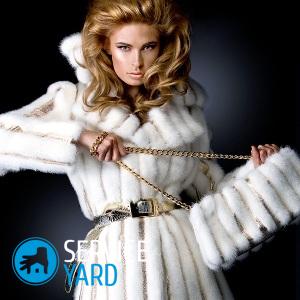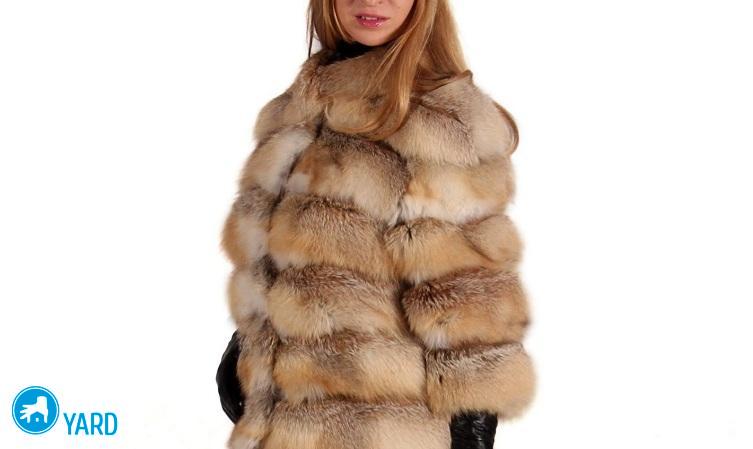How to sew a fur coat from natural fur with your own hands? Master Class

What girl does not dream of a fluffy, warm coat? Absolutely all women want to look chic in a fur product in order to catch the admiring glances of passers-by. But, alas, not every fashionista can afford a fur coat made of natural fur. Due to the high cost of raw materials and the laborious process of processing fur, vests and fur coats are very expensive. Do not get upset ahead of time. Today you will learn how to sew a fur coat from natural fur with your own hands. The master class will help any skillful needlewoman who has basic knowledge of cutting and sewing to cope with such tailoring. In order for you to gain experience in sewing skills, we recommend that you sew a fur coat of faux fur with your own hands, and after training, take up the manufacture of a product from natural fur.
to contents ↑Choose material
Before you sew a beautiful fur coat, you need to think about the material that will be used for sewing outerwear. So, let's figure it out together, from what raw materials you can sew your “creation":
- Natural fur. This material is the most expensive, as it is obtained from an animal, and not made synthetically. Only experienced seamstresses with extensive experience in working with fur can work with raw materials.
Important! Natural fur is easy to spoil, so before you get to work, weigh your creative strengths and skills well.
- Faux fur. This is the most budget option, which is great for beginner needlewomen. Short-nap cloths are easy to cut and stitch on a typewriter. The current market offers a wide selection of artificial analogues of natural fur, which are difficult to distinguish from the present, which plays an important role in creating an affordable pricing policy.
- Natural previously used fur. Surely every woman at home will have an old mother's mink coat, which needs repair, or a coat that has long gone out of fashion. After reviewing the ads and going to the “flea market”, you can get the same tidbit for a minimal fee.
How to sew a faux fur coat with your own hands? Master Class
We bring to your attention a detailed master class on making a beautiful fur coat from faux fur. For work, we took a fur imitated as a lynx, so that you could immediately understand some points that you may encounter.
Materials and tools:
- Faux fur (material is designed for size 42) - 2.2 meters.
- Lining fabric (viscose, atlas) - 1.7 meters
- Insulation (synthetic winterizer, holofiber, thin wool) - 1.7 meters.
- Flannel or any other fabric for the “probe” - 2.2 meters.
- A set of patterns (by your own standards or examples from the Internet).
- Accessories - buttons, hooks, clips.
- Adhesive backing tape (for reinforcing armholes, sleeves and shoulder seams).
- Clerical or furrier knife with a sharp blade.
- Scissors.
- Thimble.
- Long ruler.
- Gypsy needle.
- Tape measure.
- Tailor pins.
- Metal comb for even combing of the joints of fur skins.
- Ballpoint pen for marking.
Sewing fur coats with your own hands:
- We cut out the basic details for the fur coat from the fabric of the “probe”, carefully sweep away everything and try on ourselves.After fitting, we make the necessary amendments. Check the length of the sleeve and the product itself. We check the correspondence of the marks of all allowances for the seams and the hem of the bottom. Now we warm up the “probe”. We got a pattern of faux fur coats with our own hands, which we will use to cut the lining and the fur fabric.
- For work, we took a fur with a pattern, therefore, before the cutting stage, we transfer the image location with the chalk and a long line to the wrong side. We will consider these strips in the formation of patterns for faux fur and lining.
- We lay out the details of the fur fabric, given the location of the picture. Do not forget to transfer the internal details of the hood with a small selection from the pattern of the shoulder shelf. We made a full layout of all the details on the fur before the cutting process.
- We cut the fur with a well-sharpened clerical knife, wielding it from the wrong side of the canvas. Do not forget to hold the fur with your hand, cutting it into small sections, slightly pushing both sides of the canvas. Separately cut the warp threads that did not break initially. We cut out all the details with increments, a chest tuck, without cutting 1 cm from it for allowance.
- We cut the insulation and lining: the elements of the back and sleeves are cut out according to the fur pattern, and the details of the shelves are minus the hood (if one is available) and selected. We cut out all the woolen details, chip them with pins with a lining, deviating from the edge of about 2 cm. We cut out the woolen details with a lining.
- We process on the overlock chipped insulation parts and linings around the perimeter. We get single parts of the insulated textile lining, the edge of which will no longer crumble.
- We sweep and stitch the previously noted breast tuck on the lining and shelves. The tucks that turned out on the lining are carefully ironed down.
- Since when grinding the fur inevitably falls into the seam, we fix this problem by pulling it with a gypsy needle. Turn the fur product over to the front side and comb it with a metal comb.
- Cut off excess fur from the inside so that the seam is well straightened. Now our seams look appropriate.
- We sweep and grind the side seams of the shelves and back, hood and sleeves. We process the seams as in the case of tucks.
- We grind together the details of the lining shelf with fur picks for the hood. We sweep and stitch the side seams of the back, hood and shelves on the typewriter. We process seams on the back with a gypsy needle, scissors and a comb. Carefully iron all side seams on a textile lining.
- We grind the shoulder seams, and then process the internal and external seams with the above actions.
- Sew a sleeve from the lining to the side armhole of the shoulder. We perform similar manipulations with the second sleeve.
- We sew on the throat with a hood on a sewing machine.
- We put the lining in the fur product, and then try on it. You can also attach shoulder pads at will.
- We sweep and stitch the lining to the fur. We process the lower edges of the sleeves, securing them with a blind seam in one hem. Sew the shoulder pads to the textile lining.
- Stitch along the perimeter a lining with a fur cloth.
- We turn the sewn coat through the hole that is on the seam of the sleeve.
- We turn the sleeves with the hole, and then sew it with a blind seam.
- Sew buttons fasteners (you can use buttons).
A self-made fur coat made of faux fur is ready to please your happy mistress!
to contents ↑General recommendations
If you want to sew a fur coat from natural fur, then it will not hurt you to familiarize yourself with some of the nuances:
- Finding exactly the same canvases is almost impossible. That is why it is very difficult to choose the location of the skins so that the product seemed solid, without bald spots and joints. To do this, you need to deal with fur only for a professional or a very experienced seamstress.
- Do not be sure that cutting off the sleeves from the old coat, you will sew a beautiful vest. All details need to be cut, and the worn-out areas replaced.
- The basic rule of sewing any fur clothing is that the fur should be directed to the bottom of the product (pile down).
- We recommend inserting the best canvases into the most visible parts - at the center of the shelves and backs.
- Do not use scissors to cut natural and artificial fur canvases. Perform the cutting process not on a wooden, but on a plastic surface.
- Check the suitability of the fur coat in advance. For example, skins that have been in use can break even at the slightest touch of a needle. It is extremely undesirable to take such a cloth for sewing a fur coat or vest.
- If you have not found a finished pattern on the Internet, then make it yourself, take as a basis your well-fitting coat. Using the scheme of its construction of parts, you can easily make any fur coat.
Stock footage
Now you know how to sew a beautiful fur coat. Follow our helpful recommendations and you will surely succeed in showing off your new creation!
- How to choose a vacuum cleaner taking into account the characteristics of the house and coatings?
- What to look for when choosing a water delivery
- How to quickly create comfort at home - tips for housewives
- How to choose the perfect TV - useful tips
- What to look for when choosing blinds
- What should be running shoes?
- What useful things can you buy in a hardware store
- Iphone 11 pro max review
- Than iPhone is better than Android smartphones




